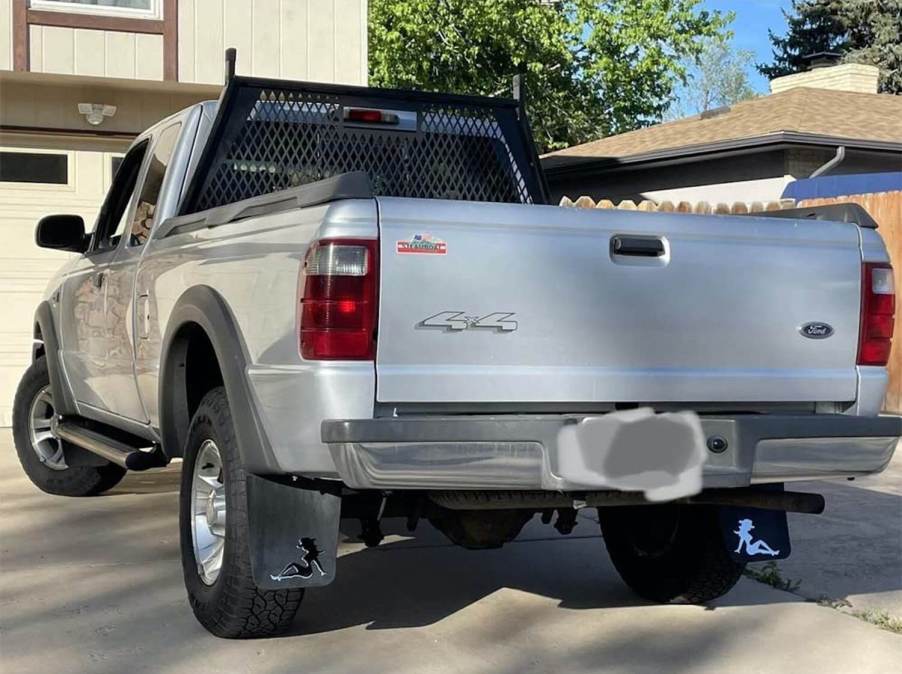
Be Respectful: The Mudflap Girl Is Based on Someone’s Actual Mother
You can’t drive the highways of the U.S.A. for long before spotting the outline of a reclining woman emblazoned on the mudflaps of a passing truck. The Mudflap Girl has been a symbol of automotive cultures ranging from long-haul truckers to custom motorcycle builders since the 1970s. Whether you love her or hate her, make sure you’re respectful. The real Mudflap Girl is apparently someone’s mother.
Is the Mudflap Girl based on a real woman?
There are multiple competing stories about the origins of the Mudflap Girl. But the story with the most evidence is that the Mudflap Girl is based on a real person: Rachel Ann Allen, beloved wife of truck driver Stewart Allen.

For years, the most common story was that Zing Enterprises in Long Beach, California first printed the famous silhouette on a mudflap in the 1960s. This tale claims the shop’s owner, Bill Zinda, based the image on an exotic dancer named Leta Laroe.
There’s only one problem with this story. According to Mel Magazine, there is no evidence of an exotic dancer with the pseudonym Leta Laroe, a man named Bill Zinda, or even a shop called Wiz Enterprises. It all appears to be made up.
The origins of the Mudflap Girl seemed destined to remain always shrouded in mystery. Then her son came forward.
Is the Mudflap Girl Rachel Ann Allen?
Ed Allen claims the Mudflap Girl was designed by his father, a truck driver. In the 1960s, Stewart Allen decorated his truck’s mudflaps with a silhouette based on a photo of his wife, Rachel Ann Allen.

The way Ed tells the story, his Dad spent long days on the road and wanted to decorate his truck to remind him of his beloved wife. In his cab, he kept a favorite photo of her reclining on a beach in a bathing suit during a family vacation. But his boss had a strict “no modifications” rule.
Then one day Stewart backed up to the loading dock and waited for his boss to begin the inspection. He realized that his mud flaps were blocked from view. It was already common for truck owners to order custom mudflaps with their logo. So Stewart Allen had a set printed up with the outline of Rachel.
When Ed Allen told his story to Wired Magazine, he threw in that in 1967, Bill Zinda complemented Stewart on his mudflaps and asked for permission to print and sell his own.
Ed has no way to confirm his story. Sadly, Stewart Allen has died, and Rachel lives with Alzheimer’s. The U.S. Patent Office believes him though. It granted Allen a trademark on the Mudflap Girl in 2010. But he and the office agree that the image has passed into the public domain, so he is not asking for a penny from the countless companies currently using it for profit.
What is the meaning of the Mudflap Girl?
Some call the image of the Mudflap Girl objectifying; others say she’s a celebration of female beauty. The supposed inventor–truck driver Stewart Allen–thought of her as a reminder of his wife, Rachel. In an era when semi-truck modifications were rarer, the Mudflap Girl also represented rebellion.

The Mudflap Girl was the 1970s equivalent of a viral meme. Throughout the decade, she spread to the mudflaps of countless semi-trucks. The ubiquitous image now graces belt buckles, custom motorcycles, and even multiple lines of cookie cutters. Moreover, the ensuing five decades have seen the rise of many variations with a deeper meaning.
When the Wyoming Public Libraries wanted to publicize its extensive collection of automotive repair manuals, it created a version of the Mudflap Girl reading a book. The Feministing blog used a Mudflap Girl holding up the middle finger as its logo for fifteen years. Ed Allen said his mom would be proud of these new interpretations of her image, adding, “Rachel is a pretty strong woman.”
Next, find out why some semi-truck trailers have a tiny door set into their main door or learn about the current state of truck driving in the video below:






